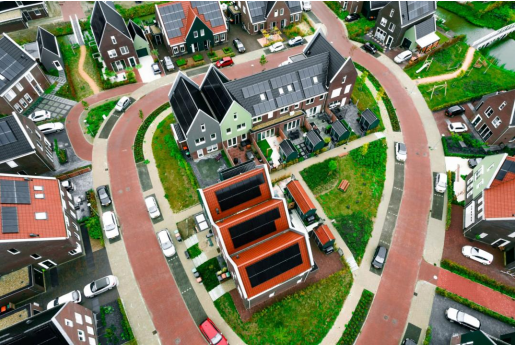What is a solar farm?
A solar farm, sometimes referred to as a solar garden or photovoltaic (PV) power plant, is a large solar array that converts sunlight into energy that is then fed into the electricity grid. Many of these massive ground-mounted arrays are owned by utilities and are another way for the utility to provide electricity to properties in its service area. These solar farms can contain thousands of solar panels. Other solar farms are community solar projects, which typically include hundreds of solar panels and can be a good alternative for households that can’t install solar on their own property.
Types of solar farms
There are two main types of solar farms in the country: utility-scale solar farms and community solar farms. The main difference between the two is the customer – utility-scale solar farms sell solar power directly to the utility company, while community solar farms sell directly to the end users of electricity, such as homeowners and renters.
Utility-scale solar farms
Utility-scale solar farms (often referred to simply as solar farms) are large solar farms owned by utilities that consist of many solar panels that supply electricity to the grid. Depending on the geographical location of the installation, the electricity generated by these plants is either sold to a utility wholesaler under a power purchase agreement (PPA) or owned directly by the utility. Regardless of the specific structure, the original customer for solar power is the utility, which then distributes the generated power to residential, commercial, and industrial customers connected to the grid.
Community Solar Farms
The concept of community solar has taken off in recent years as more and more households realize that they can go solar without installing solar panels on their own roofs. A community solar farm – sometimes referred to as a “solar garden” or “rooftops solar” – is an energy farm that generates electricity for several households to share. In most cases, a community solar array is a large ground-mounted installation covering one or more acres, usually in a field.
Advantages and disadvantages of solar farms
Advantage:
Environmentally friendly
Starting your own solar farm can be a worthwhile investment if you have available land and resources. Utility and community solar farms produce abundant, easily accessible solar energy. Unlike fossil fuels, solar energy produces no harmful by-products and is virtually inexhaustible.
Requires little to no maintenance
Solar panel technology has improved greatly in recent years and now requires little maintenance. Solar panels are made from durable materials that can withstand a lot of damage from the outside environment and require minimal cleaning.
No upfront fees for community solar farm users
If you are interested in joining a community solar farm, you may not have to pay any upfront fees. This makes community solar a great option for renters, people whose roofs are not suitable for solar panels, or people who want to avoid the cost of rooftop solar panels.

Disadvantages
There are upfront costs for the homeowner
The upfront costs of both commercial and residential solar installations are high. Homeowners wishing to build a solar farm can expect to pay between $800,000 and $1.3 million upfront, but there is the potential for a significant return on investment. Once you’ve built your solar farm, you could potentially earn up to $40,000 a year by selling electricity from your 1MW solar farm.
Takes up a lot of space
Solar farms require a large amount of land (usually around 5 to 7 acres) for the installation of the solar panels and associated equipment, repairs and maintenance. It can also take up to five years to build a solar farm.
Energy storage costs for solar farms can be high
Solar panels only work when the sun is shining. Therefore, like homeowners’ solar-plus-storage solutions, utility-scale and community solar farms require storage technologies, such as batteries, to collect and store the excess energy produced by solar panels.
Post time: Aug-25-2023